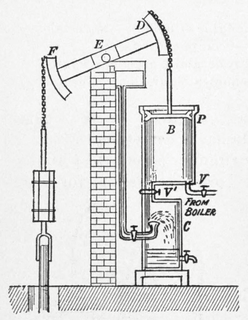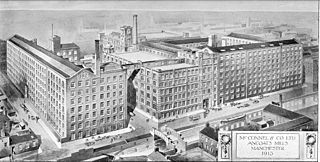
Six-column beam engines are a type of beam engine, where the beam's central pivot is supported on a cast-iron frame or 'bedstead', supported on six iron columns. [1]

Six-column beam engines are a type of beam engine, where the beam's central pivot is supported on a cast-iron frame or 'bedstead', supported on six iron columns. [1]
These engines were a development after the house-built engine. Their cast-iron frames could be built and test-assembled at a factory before delivery, allowing rapid assembly or 'erection' once on site. Their main advantage was that they avoided the need for complex masonry foundations in their engine house, merely a simple level platform to which the iron frame could be bolted. The difficult alignment between their cylinder, the beam pivot and the crankshaft was all taken care of by the factory-made frame. [2] Although the upper part of the frame only supports the beam's central pivot and any Watt's parallel motion gear, it also has an important function in stiffening the frame overall against vertical bending forces between the cylinder and crankshaft. Cast iron is weak against bending, and a shallow frame alone would need either rigid masonry support, or would soon fracture.
One of the oldest surviving six-column engines is a small engine of 1820, possibly by Boulton & Watt, preserved at the Birmingham Museum of Science and Industry. [2] Another six-column engine was within that collection, an Easton & Amos engine of 1864. This engine is rather larger and a Woolf compound. [3] [4]

Six-column engines were most popular for the smaller sizes of engine. They were all rotative beam engines, with a flywheel and rotating output shaft. These were used to drive machinery, as diverse as sugar cane crushing mills, [5] winding engines in coal mines and sawmills. Many beam engines, working into the late 20th century, [lower-roman 1] were non-rotative and drove vertical water pumps directly. These did not use the six column layout.
The small six-column engine may be considered as an early form of semi-portable engine. [2] Its pre-fabricated nature and avoidance of foundations made it quicker, thus cheaper, to first install. It also encouraged the re-use of engines on other sites. The small Birmingham engine is known to have worked on at least three different sites as a winding engine, grinding fireclay and finally as a farm chaff cutter, a working life of around 130 years. [2] [6] The Cobb's Brewery engine (1825) at Margate was one of a batch built for a sugar plantation in the West Indies, but owing to their bankruptcy before shipping it was sent instead to South America. Its ship then foundered on the North Foreland and it was purchased from the wreck for use locally. [7] The versatility of this design meant that they could be used easily by a variety of industries.
Six-column engines were not usually built outside the UK, although at least one was built by the US West Point Foundry in the 1840s and exported to the Hacienda Azucarera La Esperanza in Puerto Rico, to drive a sugar cane mill. It remains there today and in 1979 was designated as a National Historic Mechanical Engineering Landmark by the American Society of Mechanical Engineers. [8]

The twin six-column engine was used where two engines drove a shared flywheel. Typical cast-iron six-column frames were used over each engine, but joined by additional frames between them. An example of such an 1867 Kay & Co. engine from Dancers End pumping station in the Chiltern Hills is now at Kew Bridge [9]
Larger engines rarely used the six-column form, as the upper framework would become unwieldy. The weight of their large beams was more than the slim columns supporting the beam pivot could cope with. A rare form was the eight-column engine, where the pivot was supported by four close-set pillars rather than two. An example of such an engine survives at Markfield Road. [10] With the extra power of the largest engines, the bending forces on the frame would become too much altogether and these engines used either masonry beds, or a deep iron bed casting, set at the base of the engine.

A further development as a semi-portable engine was the tank-bed engine. This replaced the flat lower frame with a deep, cast-iron 'bath tub'. [11] This improved the rigidity of the frame, such that the engines could be placed on the very weakest foundations. Many of these engines, in colonial use, were merely staked down to timber baulks, rather than being built onto masonry.
Most beam engines were also condensing. Fittings such as the hot well and air pump could be conveniently placed within such a water-tight tank, so that their efflux water was contained.
A model of a tank-bed engine was the basis of Tubal Cain's model beam engine design, Lady Stephanie. [12]

The Watt steam engine, alternatively known as the Boulton and Watt steam engine, was an early steam engine and was one of the driving forces of the Industrial Revolution. James Watt developed the design sporadically from 1763 to 1775 with support from Matthew Boulton. Watt's design saved so much more fuel compared with earlier designs that they were licensed based on the amount of fuel they would save. Watt never ceased developing the steam engine, introducing double-acting designs and various systems for taking off rotary power. Watt's design became synonymous with steam engines, and it was many years before significantly new designs began to replace the basic Watt design.

The Barton Swing Aqueduct is a moveable navigable aqueduct in Barton upon Irwell, Greater Manchester, England. It carries the Bridgewater Canal across the Manchester Ship Canal. The swinging action allows large vessels using the ship canal to pass through and smaller craft, both narrowboats and broad-beam barges to cross over the top. The aqueduct, the first and only swing aqueduct in the world, is a Grade II* listed building, and considered a major feat of Victorian civil engineering. Designed by Sir Edward Leader Williams and built by Andrew Handyside and Company of Derby, the swing bridge opened in 1894 and remains in regular use.

A beam engine is a type of steam engine where a pivoted overhead beam is used to apply the force from a vertical piston to a vertical connecting rod. This configuration, with the engine directly driving a pump, was first used by Thomas Newcomen around 1705 to remove water from mines in Cornwall. The efficiency of the engines was improved by engineers including James Watt, who added a separate condenser; Jonathan Hornblower and Arthur Woolf, who compounded the cylinders; and William McNaught, who devised a method of compounding an existing engine. Beam engines were first used to pump water out of mines or into canals, but could be used to pump water to supplement the flow for a waterwheel powering a mill.

A portable engine is an engine, either a steam engine or an internal combustion engine, that sits in one place while operating, but is portable and thus can be easily moved from one work site to another. Mounted on wheels or skids, it is either towed to the work site or moves there via self-propulsion.

Walka Water Works is a heritage-listed 19th-century pumping station at 55 Scobies Lane, Oakhampton Heights, City of Maitland, New South Wales, Australia. Originally built in 1887 to supply water to Newcastle and the lower Hunter Valley, it has since been restored and preserved and is part of Maitland City Council's Walka Recreation and Wildlife Reserve. It was added to the New South Wales State Heritage Register on 2 April 1999.

The Whitbread Engine preserved in the Powerhouse Museum in Sydney, Australia, built in 1785, is one of the first rotative steam engines ever built, and is the oldest surviving. A rotative engine is a type of beam engine where the reciprocating motion of the beam is converted to rotary motion, producing a continuous power source suitable for driving machinery.

A marine steam engine is a steam engine that is used to power a ship or boat. This article deals mainly with marine steam engines of the reciprocating type, which were in use from the inception of the steamboat in the early 19th century to their last years of large-scale manufacture during World War II. Reciprocating steam engines were progressively replaced in marine applications during the 20th century by steam turbines and marine diesel engines.

A blowing engine is a large stationary steam engine or internal combustion engine directly coupled to air pumping cylinders. They deliver a very large quantity of air at a pressure lower than an air compressor, but greater than a centrifugal fan.

The Pinchbeck Engine is a drainage engine, a rotative beam engine built in 1833 to drain Pinchbeck Marsh, to the north of Spalding, Lincolnshire, in England. Until it was shut down in 1952, the engine discharged into the Blue Gowt which joins the River Glen at Surfleet Seas End.

Saxon Mill, Droylsden was a cotton spinning mill in Droylsden, Tameside, Greater Manchester, England. It was built in the 1907, taken over by the Lancashire Cotton Corporation in the 1930s and passed to Courtaulds in 1964. Production finished in 1967, and the mill was demolished in 1995.

McConnel & Kennedy Mills are a group of cotton mills on Redhill Street in Ancoats, Manchester, England. With the adjoining Murrays' Mills, they form a nationally important group.

Old Bess is an early beam engine built by the partnership of Boulton and Watt. The engine was constructed in 1777 and worked until 1848.

A semi-portable engine is a form of stationary steam engine. They were built in a factory as a single unit including the boiler, so that they could be rapidly installed on site and brought into service.

Grasshopper beam engines are beam engines that are pivoted at one end, rather than in the centre.

A house-built engine is a stationary steam engine that is built into an engine house, such that it uses the masonry of the engine house as an integral part of the support of the engine.

A return connecting rod, return piston rod or double piston rod engine or back-acting engine is a particular layout for a steam engine.

A cataract was a speed governing device used for early single-acting beam engines, particularly atmospheric engines and Cornish engines.
Resolution was an early beam engine, installed between 1781–1782 at Coalbrookdale as a water-returning engine to power the blast furnaces and ironworks there. It was one of the last water-returning engines to be constructed, before the rotative beam engine made this type of engine obsolete.

Fairbottom Bobs is a Newcomen-type beam engine that was used in the 18th century as a pumping engine to drain a colliery near Ashton-under-Lyne. It is probably the world's second-oldest surviving steam engine. The engine was installed at Cannel Colliery at Fairbottom near Ashton-under-Lyne around 1760 or 1764. It became known locally as Fairbottom Bobs.

The Wanlockhead beam engine is located close to the Wanlock Water below Church Street on the B797 in the village of Wanlockhead, Parish of Sanquhar, Dumfries and Galloway, Scotland. The site is in the Lowther Hills above the Mennock Pass, a mile south of Leadhills in the Southern Uplands. This is the only remaining original water powered beam engine in the United Kingdom and still stands at its original location. It ceased working circa 1910 after installation circa 1870.
| Wikimedia Commons has media related to Tank bed beam engines . |
| Wikimedia Commons has media related to Six-column beam engines . |